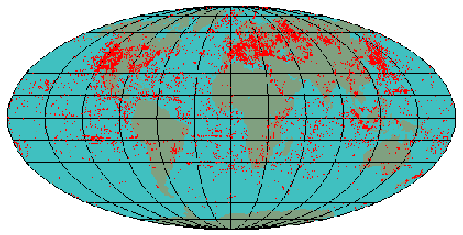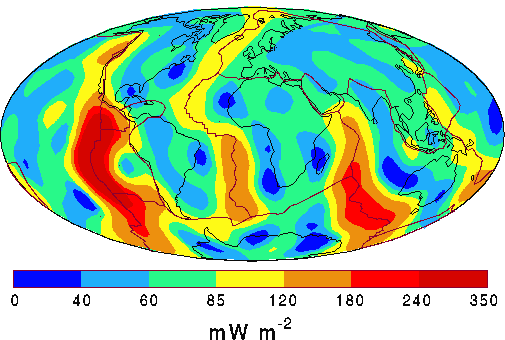Global Heat Flow
The present Global Heat Flow Data Base, compiled by Pollack et al.
(1993), was a project initiated by
the International Heat Flow Commission of the International Association of Seismology and
Physics of the Earth's Interior (IASPEI). The new compilation provides a decade update of an earliear
1976 compilation. A description and analysis of the data set appears in: Pollack, H.N., Hurter,
S.J., and Johnson, J.R., Heat flow from the earth's interior: analysis of the global data set,
Reviews of Geophysics 31(3), 267-280, 1993.
Location of Heat Flow Sites

To FTP the Data Set
The global heat flow data base has been turned over to the
US National Geophysical Data Center (NGDC) for distribution. Click
here
to ftp the data set from NGDC.
Please note that the data set requires approximately 2,297,930 bytes when uncompressed. If you have
any difficulty downloading or uncompressing the data set from NGDC, please send an email to
Shaopeng Huang [
shaopeng@umich.edu], he will be happy to make the electronic file available at their site.
Next Compilation of Heat Flow Density
William D. Gosnold
of the University of
North Dakota has been appointed as interim custdodian of the global heat flow compilation.
He has converted the global heat flow data set to spreadsheet format (Microsoft Excel) and stored it
on a
server at the
University of North Dakota.

This map shows color-coded contours of the global distribution of heat flow at the surface of the Earth's crust.
Major plate boundaries and continent outlines are also shown. The fundamental data embodied in this map are the
more than 24,000 field measurements in both continental and oceanic terrains, supplemented by estimates of the
heat flow in the unsurveyed regions. The estimates are based on empirically determined charactersitic values
for the heat flux in various geological and tectonic settings. Observations of the oceanic heat flux have been
corrected for heat loss by hydrothermal circulation through the oceanic crust. The global data set so assembled
was then subjected to a spherical harmonic analysis. The map is a representation of the heat flow to spherical
harmonic degree and order 12.
Activities 2007 - 2009
The IHFC heat flow
data bank (http://www.heatflow.und.edu/)
is currently located under the custody
of William Gosnold at the University of
North Dakota.
It
contains both marine and continental
data. In the reporting period, there
have been no submissions of new heat
flow data to the database. Will Gosnold receives
inquiries or requests for assistance
about once per week and responds
immediately.
During the IUGG general assembly in
Perugia in 2007, the IHFC discussed the
need for an update of this data bank
since much data has been collected in
various scientific projects but also by
the hydrocarbon industry since the
current data base was established .
However, such an update would require
funds on the order of 120
k€ -
150 k€. Since the Perugia meeting,
IHFC member Heinrich Villinger therefore
explored available options for a funding
of such a project by the German Science
Foundation (DFG).
However he obtained a somewhat
discouraging response: Such an effort
could be funded only if new and exiting
results can be expected once the data
base is in good shape and up-to-date. In
our opinion, such an update would
therefore need to include the
proprietary industry data. The interest
of industry in marine heat flow is
slowly increasing but still not huge.
Therefore, the commission will need to
discuss whether it will be realistic to
set up an industry consortium to collect
appropriate funds. This discussion has
not come to an end yet, and former heat
flow researchers now working for the
hydrocarbon industry are going to be
contacted for advice and help.
A
major new development is that we may
find a solution to this long standing
issue of lacking support for managing
the data base. Will
Gosnold is planning to meet with
representatives from GOOGLE during the
AGU Fall Meeting 2008. This meeting was
organized by David Blackwell who has
received a major financial
contribution from GOOGLE to develop
information on geothermal energy. Talks
with GOOGLE representatives indicate
that they may be willing to commit a
substantial amount of funding to support
the data base and to include it on their
website. GOOGLE is promoting geothermal
energy as a principle energy source for
the future, and linking the heat flow
data base with their program would
provide a sustainable platform for the
IHFC data base.